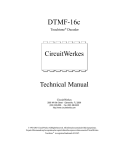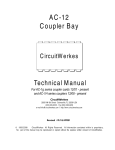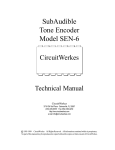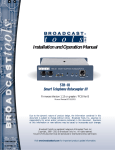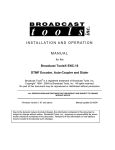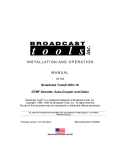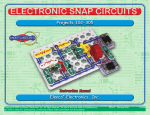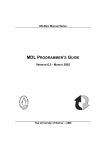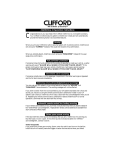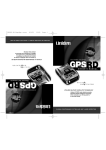Download Original DTMF-16 Book
Transcript
For Original DTMF-16 (circa 1992-93) without Jumpers J3 & J4 CircuitWerkes DTMF-16 Installation & Service Manual Description The CircuitWerkes DTMF-16 is an integrated Touch Tone detector and sixteen output decoder, offering an optoisolated Darlington output for each of the sixteen standard DTMF tones. Seperate emitters and collectors are available for each of the twelve "common" DTMF tones, 1-9, 0, *, and #. Seperate emitters and a common collector are brought out for DTMF Tones A, B, C, and D. The open collector Darlington outputs provide 5000 volts of isolation and are capable of sinking up to 150mA continuously (emittercollector voltage should not exceed 30 volts). These outputs along with 12 volts DC (unregulated), and various internal test and interface signals are available at the unit's D-SUB 37 pin connector. Installation & Operation Setup The DTMF-16 comes from the factory ready to use, just hook up an audio source to the tip and ring (the sleeve is left floating) on the DTMF-16's 1/4" audio input jack, connect your equipment to the supplied DB37 male connector, plug in the power supply and it's ready. Typical hookup diagrams are supplied in the schematics section at the end of this manual.. There are six jumpers on the DTMF16 board; all except for the mode jumper & beep acknowledge are set "CLOSED" from the factory. The Mode jumper when "OPEN" selects momentary decoder operation. The momentary output is activated only for the duration of the incoming DTMF tone. When the mode jumper is closed the decoder is in (interlocked) latching mode. When in latching mode the selected output remains activated until another output is selected. The second internal jumper (near the 4093 chip) enables the acknowledge beep when installed. The beep jumper is normally shipped in the open mode when the DTMF-16 operates by itself . The jumper is normally set in the closed position when the DTMF-16 is part of a combined autocoupler circuit such as the AD-16. The remaining four jumpers, labelled A-D, are simply in the paths of the A-D outputs of the decoder; they are normally installed in the closed position at the factory. In the closed position outputs A through D appear on the D-37F output connector. If needed,the jumpers can be removed and the corresponding four pins of the D-37F output connector can be accessed for other purposes. For example, special ComboLok options can be interfaced to the outside via these pins. 1 Basic Operation The DTMF-16 requires no operator intervention. It monitors an audio source until a valid DTMF tone occurs, then energizes the tone's corresponding (Darlington output) optocoupler. The resulting open collector output appears on the unit's db37 connector. Connections The power connection is made via 2.1 mm coaxial jack and will accept from 8 to 18 Vac. A power supply is provided with each DTMF-16; however, if you wish to supply your own, it must be able to provide at least 150ma. The DTMF-16's audio connection is made via the 1/4 inch jack located next to the power connector. The connector is a tip, ring & sleeve type with the tip & ring making the audio path. The audio input is an unbalanced input with an input impedance of approximately 10kOhms. Input impedance of the DTMF-16 is 600 Ohms when it is packaged with (and connected to) the AC-2 autocoupler. Audio input level must be between 0.5 and 10 volts peak to peak Care & Feeding Generally, the DTMF-16 may be placed anywhere other electrical equipment is in operation. As always, it is best to avoid extreme temperatures, immersion, or high impacts. If you wish to clean the outside of the DTMF-16, use a damp cloth soaked in a mild soap and water solution. Detergents, alcohol, or solvents may remove the screen printing or mar the case. Theory of operation Input audio is capacitor coupled to the Silicon Systems SSI202 low power DTMF receiver. The SSI202 requires only one resistor and one crystal for frequency reference. The hexadecimal coded output is decoded by the CMOS 4514 4 to 16 line decoder. The hex-coded BCD data is connected directly to the 4514 decoder; but the data valid (strobe) pulse from the SSSI202 drives the bases of two npn switching transistors, q1 and q2. q2's sole purpose in life is to be an inverter/buffer of the DV pulse for the accessory header (2x4 pin header) located beside the 4514 chip. q1, more importantly, pulls up the Follow pin (pin 1) on the 4514 and turns on transistors q3 and q4 during the DV pulse. When q3 is thus energized, it pulls the INHibit pin (pin 23) of the 4514 low, enabling the chip to place a high on the output selected by the SSI202's hex-coded BCD data. Meanwhile, q4 turns on and then back off with the DV pulse. q4's high-going (trailing) edge triggers the DTMF acknowledge beep circuit. The 4093's pin 10 (u6c) goes high for a short period of time (determined by c9 and r12) after q4's high-going edge occurs. U1d inverts u1c's pulse and gates the oscillator (formed by u1a, u1b, c8, r10, and r11) for the duration of the pulse. The resluting short burst of mdirange square waves is cap coupled to the audio input so that any valid DTMF tones is followed by a brief acknowledge beep. If the DTMF-16 is not being used in a situation where a confirmation that the DTMF tone was decoded is desired, jumper J2 can be pulled to disable the beep. When the decoder is set (via jumper 1) to interlocked latching mode, the INHibit pin of the 4514 is always held low, keeping the last-selected output activated until a new DV pulse (accompanied by new BCD data) occurs. The 4514 directly drives the 16 darlington optocouplers to saturation. The Optocouplers are quad packaged for higher density board designs. An onboard 5 volt regulated supply easily handles the circuit's power needs. 2 Trouble Shooting Problem: Solution: DTMF-16 outputs test good but won't activate my equipment. Polarities (on a logic input) may be reversed; In some computer related cases, a different version of the DTMF-16 output chip may be required, replacements are available free from the factory. Adding an external relay can also solve this problem. Problem: Cause: One or more outputs do not operate with an incoming tone. Failed optocoupler(s), failed 4514, or low and/or noisy input. Problem: None of the outputs function with incoming tones; BCD data (during incoming tone) good at pins 1, 18, 17, 16 of the SSI202. Incorrectly wired output connector, bad 4514, bad q1, q3, or r3/r4 open. Cause: Beep works. Problem: Solution: No outputs function and there is no BCD data on pins 1, 18, 17, or 16 of the SSI202. Power supply failure (check bridge first), improper audio input, bad SSI202 or damaged crystal Problem Cause: No beep. Outputs functioning properly on db37. 4093 failed or "ack" jumper removed. Note: Excessive current through the emitter collector junction of the optocouplers will destroy them. Options The DTMF-16 can be packaged with the AC-2 autocoupler to provide a fully integrated 16 output remote control. Also available is the CircuitWerkes digital combination lock, a four digit sequential combination lock with over ten thousand possible combinations. The combination lock will enable the DTMF-16 only after the correct sequence of numbers is entered. If also used with an AC-2 the combolok can force the coupler to hang up on a caller that does not enter the correct security combination within a short time window. Contact your CircuitWerkes Dealer for more information on CircuitWerkes products. 3 DTMF-16 Layout Diagram 8 pin accessory header J2 - Mode Jumper On - Latching (see text) Off - Momentary J1 - Acknowledge beep On - Enable acknowledge tone Off - Disable acknowledge tone 37 pin D-sub output connector J - 3(a), J-4(b) can be removed (disabling the A and B outputs) so that the corresponding D-Sub pins (7 and 25) can be used by other assemblies in the product enclosure, like the optional ComboLok (see OPTIONS). J-5 and J-6 connect the C and D emitter outputs to D-sub pins 24 and 6 respectively. Also can be used as described for J3 and J4. 4 5 Typical DTMF-16 output wiring. Specific examples for interfacing the DTMF-16 to relays and TTL/CMOS inputs can be found on page 8. 6 7 8 Appendix A Simple Tone Detection Delay/Anti-Falsing Filter that You can Build to Interface with the DTMF-16 Description: In applications where the DTMF-16 decoder is used in the presence of random voice audio, occasional music or speech passages may contain frequency combinations that cause the decoder to activate. In almost every case, the offending passage lasts for less than 1/10 of a second. The anti-falsing filter works by slowing down the DTMF decoder’s ability to detect the tones. Since a decoder using the filter can only see tones longer than the timing window, spurious tones are rejected. The anti-falsing filter is designed to connect to the DTMF-16 decoder board’s 2 by 4 I/O connector and provides additional immunity to spurious audio transients while still reliably detecting DTMF tones. The circuit shown is simplified in order to be easily built. A deluxe version of this circuit that includes a tone activated audio mute is available as a field installable board for a nominal charge from your CircuitWerkes dealer. Connections: Four connections are required to interface the filter to the DTMF decoder. All four of these connections should be made on the 2 by 4 pin header located between C7 and R9 at the back of the board. The four connections are, Vcc, Ground, Enable input, & Data Valid strobe output. These four pins are located in a row closest to the edge of the board. Note that the four pins that make up the inside row (closest to Q3) are labeled A through D. No connection should be made to these pins. An Insulation Displacement Connector (IDC) or Molex type pin connectors should be used to make connections to the DTMF board. Care should be taken so that no wires touch each other, particularly Vcc and anything else. Since both ground and ground sinks are present on some pins, accidentally touching them to Vcc may have very unpleasant and destructive results for both the DTMF-16 and the filter. How does it work? (Theory of Operation) U1 is a 4093 quad NAND gate. U1a & U1d are designed to act together as a non-inverting buffer insuring that input signals to the timing section of the filter circuit are clean and predictable. Each time a DTMF tone is detected, the DTMF16’s internal DV transistor pulls the input of U1a low causing it’s output to go high. U1d’s input is tied to U1a’s output so that it inverts the high output back to the original low output of the DV transistor and sinking U1b’s input via time constants R1, R2 & C1. U1 is configured as an inverter and holds the DTMF-16 in a disabled state when no DTMF tones are present. When capacitor C1 is discharged to about 1/2 Vcc U1b changes states. The time that it takes to discharge C1 is the detection delay. Decreasing the value of R1 will allow C1 to discharge more rapidly shortening the detection delay. The output of U1b is fed to the En input which is held low until the time constant expires enabling the DTMF-16. When no DTMF tones are detected, U1d’s output is high and charges C1 back up to Vcc via R1. U1’s unused gate input is tied to ground to prevent destructive oscillation. Note about parts substitutions: U1 is a 4093 Schmitt-triggered quad NAND gate which provides clean output switching in the presence of a slowly changing input. Although this circuit design was tested and found to work using the more common 4011 NAND gate, it is not guaranteed to function correctly in every case where a 4011 is substituted. 9 REPAIR OR SERVICE INFORMATION In the event of the need for service or repair, call CircuitWerkes at (352) 335-6555 for a Return Merchandise Authorization number (RMA). Then carefully package the unit along with a note of the problem and send it to the address below. Clearly indicate the RMA number on the outside of the box. We cannot accept returns without an RMA. Be sure to include your address (not a PO box), telephone number and best time to call. CircuitWerkes ATTN: CUSTOMER SERVICE DEPT. 2805 NW 6TH STREET GAINESVILLE, FL 32609 CircuitWerkes Limited Warranty This product is warranted against defects for two years from date of purchase from CircuitWerkes and CircuitWerkes authorized distributors. Within this period, we will repair it without charge for parts and labor. Proof of purchase-date required. Warranty does not cover transportation costs, or a product subjected to misuse, accidental damage, alteration (except as authorized by CircuitWerkes), improper installation, or consequential damages. Except as provided herein, CircuitWerkes makes no warranties, express or implied, including warranties of merchantability and fitness for a particular purpose. Some states do not permit limitation or exclusion of implied warranties; therefore, the aforesaid limitation(s) or exclusion(s) may not apply to the purchaser. This warranty gives you specific legal rights and you may also have other rights which vary from state to state. 10










